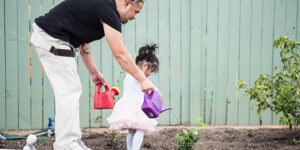
Spreading what works in education
How do you spread effective practice? SVA proposes a framework for educational and school leaders to spread what works through the education system – to turn bright spots into a bright system.

- More consistency is needed across the education system so that students from disadvantaged backgrounds have the opportunities that a good education provides.
- Various system shifts can motivate more schools to adopt practices that work, for example through user demand and by developing communities of practice.
- SVA outlines a two-layer approach to school improvement which provides a sequence of methods for leaders to make effective practice easier to adopt; and the social learning processes to support this.
The Australian school education system is good but inconsistent. The evidence shows that there is a correlation between student performance and their socio-economic status (SES). By the age of 15, students from disadvantaged backgrounds can be more than two years behind their peers. However, the evidence also shows that there are exceptional schools achieving outstanding results for these children from low SES backgrounds. The schools circled in Figure 1 are those in communities in the bottom half of socio-economic status whose students perform better than average and in some cases as well as those from the best performing schools in the country. SVA calls these schools ‘Bright Spots’.
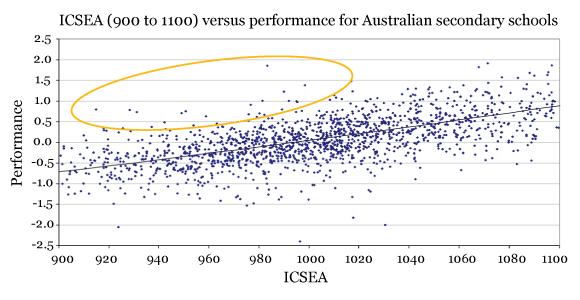
Dr Kevan Collins, CEO of the UK’s Education Endowment Foundation (EEF) says, “Across our systems, schools demonstrate that outstanding performance is possible. But the variation between similar schools, serving all types of communities, is wide.”
“The next step is to strive for a system which is reliable: where every child of any background can fulfil their potential and make the most of their talents.”
How can successful approaches or practices in the exemplary schools be spread to other schools, so that all students with a low SES background have the opportunities that a good education provides?
SVA gathered experts and educators in the field at the fourth SVA Education Dialogue to explore this question of spreading what works across the whole system. The Education Dialogue brings together leaders from education (including from some of the Bright Spots schools), philanthropy, business, government and academia who are in a position to make a difference at a practical, policy and political level.
What motivates a school to improve
David Albury, a Director of the Innovation Unit (UK) and formerly Design and Development Director to the Global Education Leaders’ Program (GELP), acknowledged that making changes at a system level to facilitate the spread of good practice is complex and difficult work.
User demand can create a compelling case, as well as provide the passion and urgency for change…
“Moving from isolated examples of great practice to widespread great learning has evaded educational systems for decades,” said Albury.
However, he identified a number of system shifts which will motivate more schools to adopt practices that work.
One is demand from the users – students, parents, the local community or employers. “User demand can create a compelling case, as well as provide the passion and urgency for change,” said Albury.
Another way that schools can be encouraged to improve is when they see similar schools that are doing excellent work. To make this happen more often, systems can encourage the growth of nested communities of practice, engagement and interest (see Figure 2).
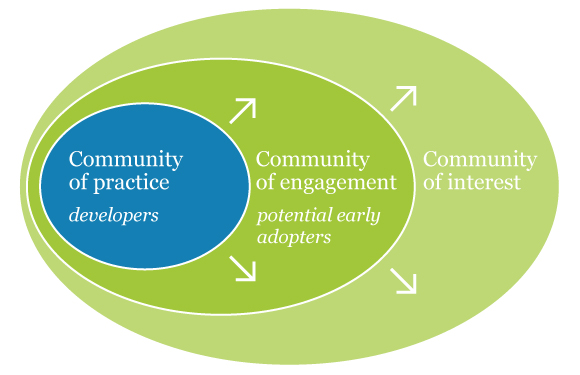
Schools in the community of interest can see the excellent work in the community of practice, which motivates them to try similar work themselves. When they do, they become part of the community of engagement and eventually the community of practice. As more schools enter each of these communities, the excellent practice at the heart of the community – a specific approach to teaching and learning, for example – spreads to improve outcomes for more students. By ‘practice’ we mean any specific method or broad approach to teaching and learning.
So once a school – or group of schools – in the community of interest is inspired to improve its teaching practices, how does it go about it?
Approaches to spread effective practice within schools
At the Education Dialogue, SVA presented a two-layer approach to school improvement in teaching and learning: learning architecture (Figure 3) and social learning processes (Figure 4).
The elements of the learning architecture show a sequence of methods that leaders can use to make new, effective practice easier to learn. The social learning processes rest on the truth that spreading good practice is essentially a social process – about people learning with and from other people – even when the practice is easy to learn.
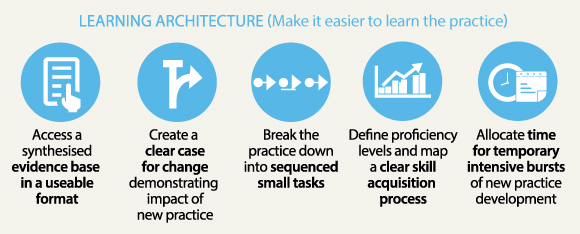
The five components of learning architecture
Access a synthesised evidence base in a usable format.
Once a school leadership team has decided it wants to change its practice, the first step in assessing the best strategies to make this happen is to reference existing evidence.
… you need data that has been synthesised so that it is accessible, easy to understand and geared to educators’ needs.
Kevan Collins elaborated on this point. “The question when adopting a new practice is how wide do you cast your net? Is it to the school down the road, at a conference or the experience of millions of students?” said Collins. “While you do need to verify that an approach works in your setting, it’s easier to check out what’s already been invented, rather than working from scratch. If you have access to a compilation of high quality research evidence, you’ll be able to make a better decision on much more evidence.”
Given the massive volume of research evidence about effective practice accumulated over recent decades, for this to be feasible, you need data that has been synthesised so that it is accessible, easy to understand and geared to educators’ needs.
The EEF provides one such solution to this problem. An independent grant-making charity dedicated to improving the attainment of disadvantaged students, EEF has created the Teaching and Learning Toolkit. This online toolkit synthesises the effectiveness and cost of more than 30 education approaches, based on meta-analyses of the most rigorous educational research. It allows teachers and schools to assess options about how to get the maximum educational ‘bang for their buck’ both in choosing effective practices and in implementing them well.
As Collins emphasised, this evidence base needs to be constantly added to and built on so that we keep learning from effective practice.
Create a clear case for change demonstrating impact of new practice
Once the practices are chosen, school leadership needs to state the case for change: Why the current situation isn’t good enough, what the goal is in applying this new practice, what ‘approach’ or practice has been chosen to achieve that and why it has been chosen. When teachers and others in the school community know why they should adopt a new practice, they are more motivated to learn that practice. It is hard to learn something you don’t see as valuable.
One of the common barriers to adopting a new practice is the belief that a practice that was effective in another context will not have the same impact in this school. When the case for change is based in evidence and clearly articulated, it can help change this attitude.
Break the practice down into sequenced small tasks AND Define proficiency levels and map a clear skill acquisition process
Many effective teaching practices are complex to learn and deliver. So, even though teachers may see value in a new practice, they may still be overwhelmed by its complexity. To make adopting the new practice less overwhelming to teachers, the practice can be broken down into a sequence of smaller steps or tasks. Teachers can thus focus on mastering the smaller parts individually and have the feeling of making progress rather than being frustrated that they haven’t immediately mastered the whole practice.
There are two other important pieces here. If teachers also have a clear sense of their progress against established benchmarks of proficiency as they learn, they will be more likely to persist in learning. Thus it’s important for a school to have clearly defined levels of proficiency in the practice. Further, if teachers go through a well-structured process of learning the parts of the new practice – just like the processes they develop for their students – they’ll find it easier to learn.
Allocate time for temporary intensive bursts of new practice development
Even with the above elements in place, some schools expect teachers to translate the new practice into their own classrooms in their own time. Under these conditions, teachers easily fall back into ingrained habits and routines or simply do not have time to do the extra work required to integrate the new practice. School leaders can overcome these barriers by allocating time for teachers to try the new practice in intensive bursts. In such a burst, teachers would have dedicated time to integrate the new practice in a short timeframe, making it more likely that they would overcome the inertia of ingrained habits.
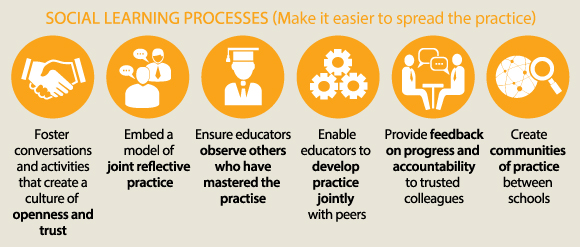
The six components of the social learning processes
As important as it is to make a new practice easy to learn, getting many people to learn a new practice is inherently a social process. Without attending to the relationships between people and how they learn with, and from, each other, the elements of the architecture won’t achieve anything.
The practice will spread at the speed that we can build trust with people who are not like us.
The six elements below will make it easier for a new practice to spread within a school.
Foster conversations and activities that create a culture of openness and trust
As Simon Breakspear, Founder and CEO of LearnLabs, said at the Education Dialogue: “The practice will spread at the speed that we can build trust with people who are not like us.” Within a school, the level of trust between staff members is part and parcel of the school culture. Ultimate responsibility for a school culture sits with the school’s leadership.
Melissa Proctor, Principal at Bass Hill Public School in Sydney’s west, described one way she is creating a culture of trust and openness. She invited each teacher to share one success at a staff meeting dedicated to celebrating the good work already happening at the school. Demonstrating the fundamental belief that everyone is doing good things and acknowledging that good work helped to create more trusting relationships among the staff. As a result of this meeting, several experienced teachers visited the classroom of a junior teacher whose innovative methods they had previously been sceptical of and adopted elements of her practice.
Embed a model of joint reflective practice
At Bass Hill Public School, Jodie Clarke is an Instructional Leader, who supports teachers in the kindergarten to Year 2 level under the NSW Government’s Early Action for Success reform – focused on raising numeracy and literacy outcomes for students in disadvantaged schools. She works with teachers to reflect on their practice so they can be more effective with their students.
You need provision in the timetable for the teachers to share and reflect about teaching and learning, and to have the space and time to try things.
With support from the principal, Clarke takes a group of teachers out of the classroom every three to four weeks to reflect on their literacy and numeracy teaching – particularly for students identified as being below grade expectations. The teachers reflect on their students’ work, identify which methods have been most effective, and decide together how to improve even further so their students learn more. When a model like this is embedded in a school – with an open and trusting culture – more teachers have the opportunity and social incentive to improve their practice.
Dean of Teacher Education at Singapore’s National Institute of Education, Woon Chia Liu talked about the importance of providing such a model for teachers: “You need provision in the timetable for the teachers to share and reflect about teaching and learning, and to have the space and time to try things.”
Ensure educators observe others who have mastered the practice
Sometimes, teachers who want to adopt a new practice are reluctant because they do not know whether they are doing it well. One way to overcome this barrier is to ensure that, as part of the skill acquisition process (see above), they observe someone who has already mastered the practice. Then, as they try to implement the practice themselves, they have a reference point for whether they are doing it well. School leaders can meet this need in a number of ways. At two of the SVA Bright Spots schools, principals have hired external experts to model effective practice. At another, they have drawn on experienced teachers within the school to provide modelling for teachers still learning a new practice.
Enable educators to develop practice jointly with peers
Schools are often overrun with changing policy and priorities. In this setting, experienced teachers may dismiss a new practice as merely one in a long line of new priorities they’ve been asked to accept. One way school leaders can overcome this attitude is by creating opportunities and incentives for teachers to develop new practice with each other. This can take the form of professional learning communities.
In a school, a professional learning community brings a team of teachers together to identify a common instructional problem and to design and implement an intervention. The group can continue to reflect and test the new practice and support each other in applying it. To do this process well, the group might consider some of the elements of the learning architecture above, such as accessing the evidence base, breaking the practice down into sequenced small tasks or defining proficiency levels and mapping a clear skill acquisition process.
Provide feedback on progress and accountability to trusted colleagues
Often, a new practice does not bear fruit immediately, and thus teachers may not persist with it because they can’t see results with their students. In this case, having an experienced colleague observe and provide feedback can help the teacher stick with it. The colleague can share his or her experience of the long-term impact of the practice. Of course, having such observation and feedback also helps to ensure a level of quality in the new practice, so that there is a higher likelihood that it will be beneficial for student learning. Such feedback works best in a culture of trust and openness and, if done well, is one of the most effective methods of improving the practice of individual teachers.
Create communities of practice between schools
Teachers often resist implementing a practice that has been successful in another school because they believe the context of their own school is completely different, so the practice won’t have the same impact. Creating a community of practice between schools offers school leaders a way to overcome this kind of resistance. When teachers collaborate on problems that are meaningful to them with schools they perceive to be like theirs, they are more likely to adopt a new, effective practice from the other school. These communities of practice can take many forms.
… such communities of practice can form the nucleus of wider communities of schools…
At the Dialogue, Liu described how Singapore’s education system creates these learning communities. “We use an intermediate platform to connect, collaborate, co-construct and communicate,” said Liu. “For example, in the Subject Chapters four to eight educators (from different schools) collaborate based on subject learning issues.” So history teachers from different schools, for example, work together on common instructional problems.
In Australia, the Australian Institute for Teaching and School Leadership (AITSL) through its Learning Frontiers is helping to create such communities. Learning Frontiers is a collaborative initiative which brings clusters of schools and other interested parties together into ‘design hubs’ to explore professional practices that increase student engagement in learning.
SVA also does this by connecting and empowering the school leaders through the Bright Spots Schools Connection (the Connection). The first cohort includes eight primary and secondary schools from New South Wales and Victoria. SVA provides various resources over five years to help the leaders to apply new practices or approaches to support students from disadvantaged backgrounds. The school leadership teams come together every three months to share their experiences and insights around their projects, and many of them have sent teams of teachers to each other’s schools to observe and learn from each other.
As David Albury has indicated, such communities of practice can form the nucleus of wider communities of schools that also begin a process of improvement, leading to better outcomes for their students and, eventually, translating bright spots of effective practice into a bright system where all students from a low SES background have the opportunities that a good education provides.
Your insights and experiences
SVA intends that the framework articulated above will contribute to the emergence of that bright system. These are early days in our thinking; we will review and refine the framework to make it more robust to inform our work. We invite you to help us with this process.
Special thanks
The SVA Education team extends its heartfelt gratitude to Simon Breakspear, founder and CEO of LearnLabs, whose combination of brilliant insight, probing questions and good humour made a significant contribution to the development of this framework.
Author: John Bush
[1] ACARA 2010, Index of Community Socio-Educational Advantage Generation Report
[2] Redesigning Education: Shaping Learning Systems around the World, Chapter 4, pg 98, Innovation Unit for the Global Education Leaders Program, David Albury, principal author of Chapter 4.




